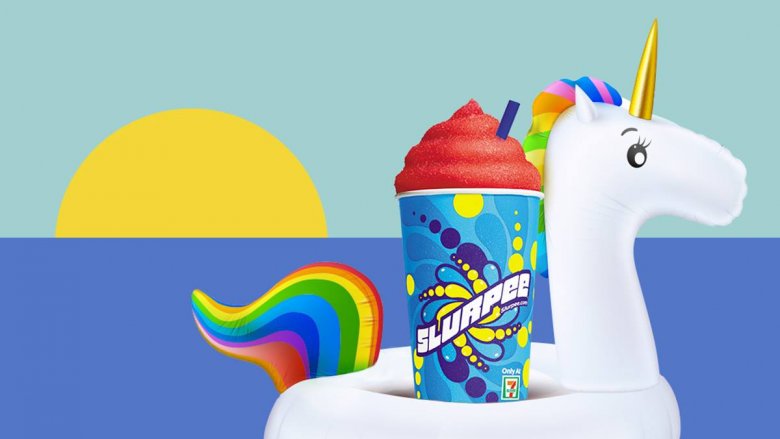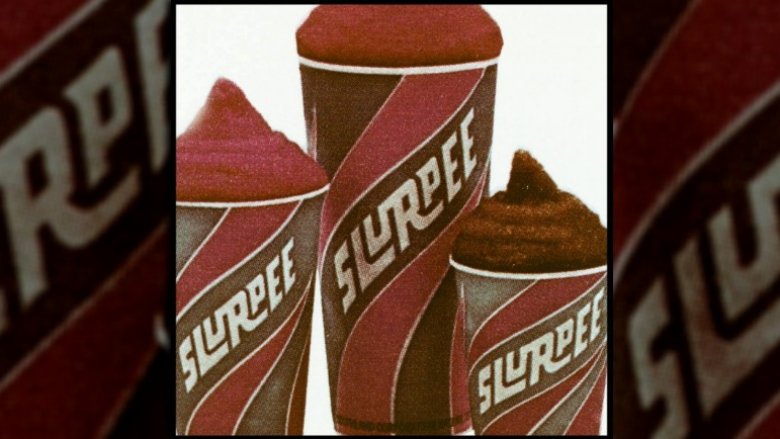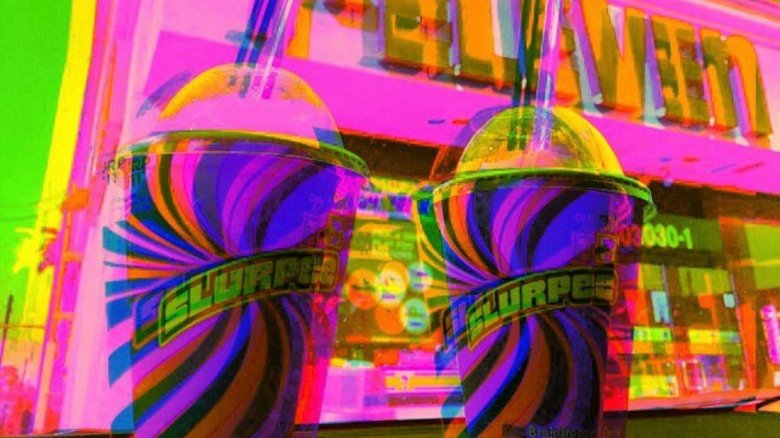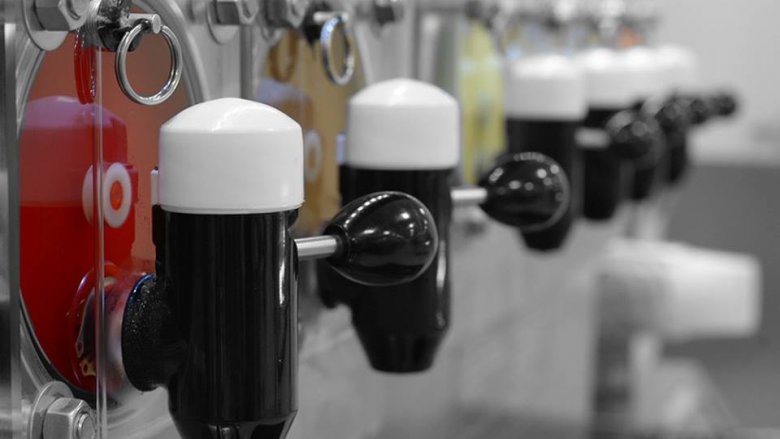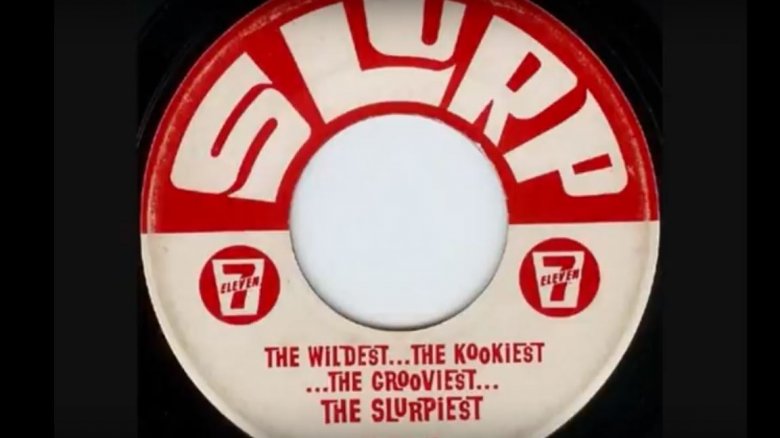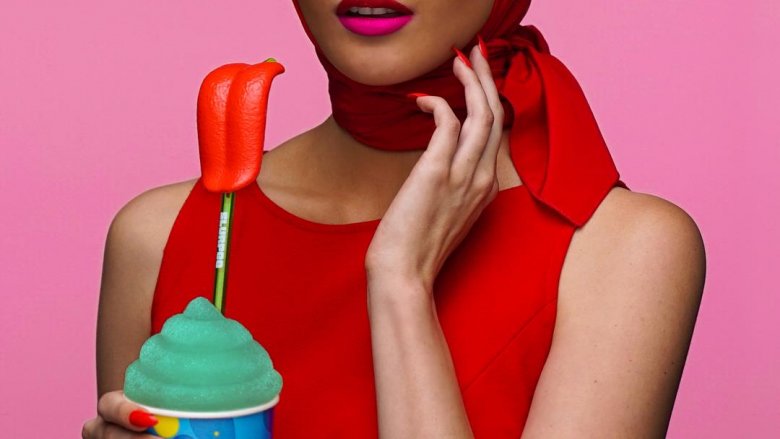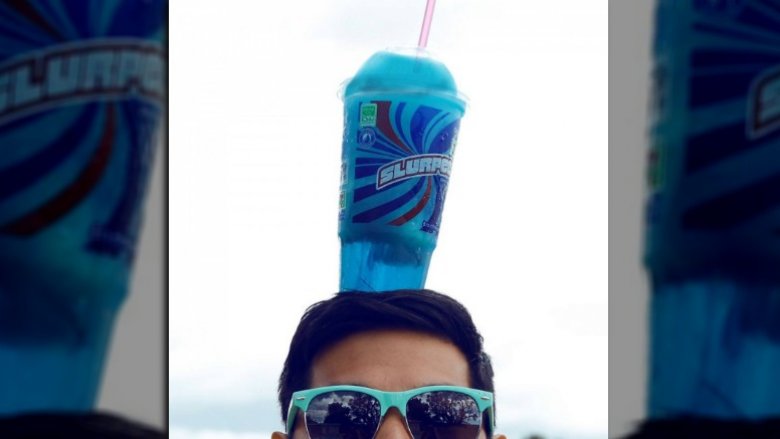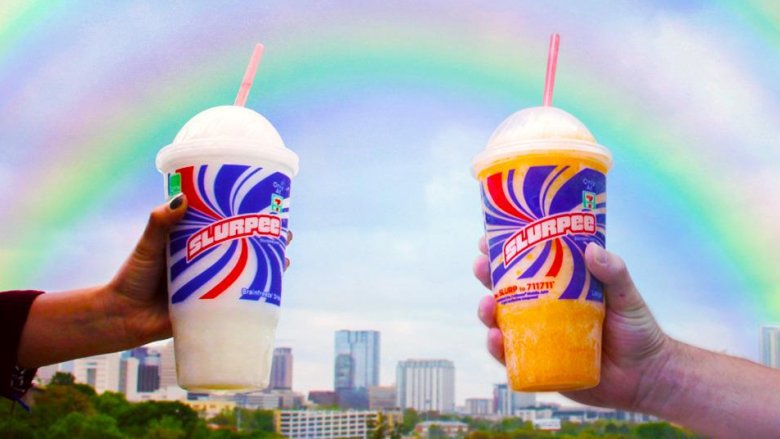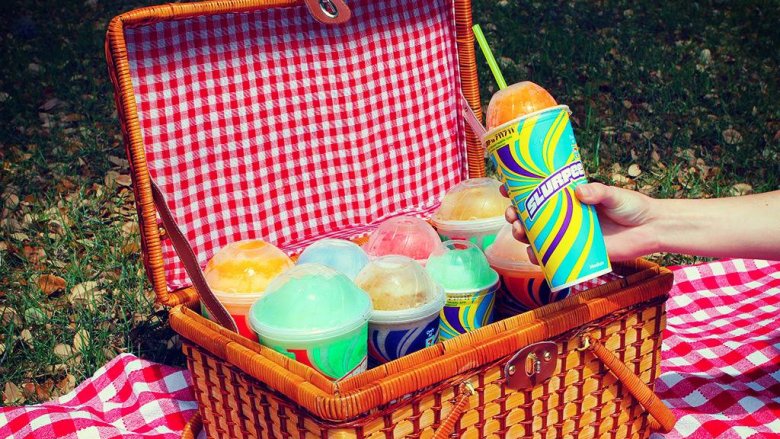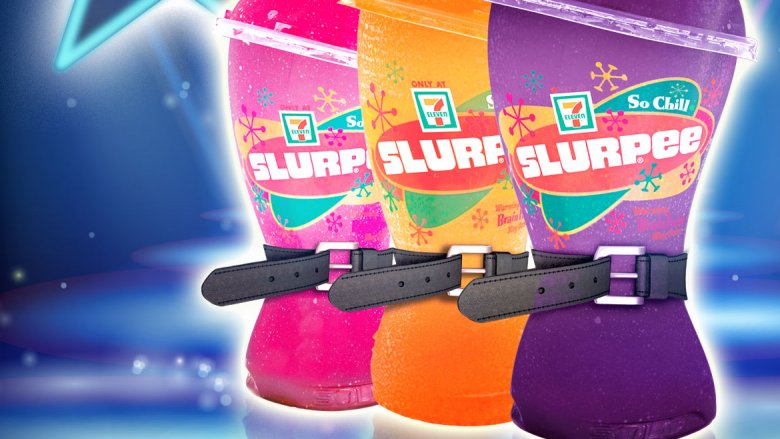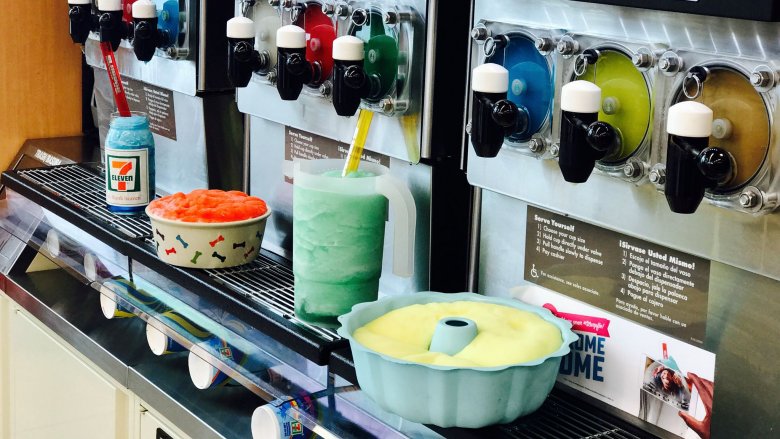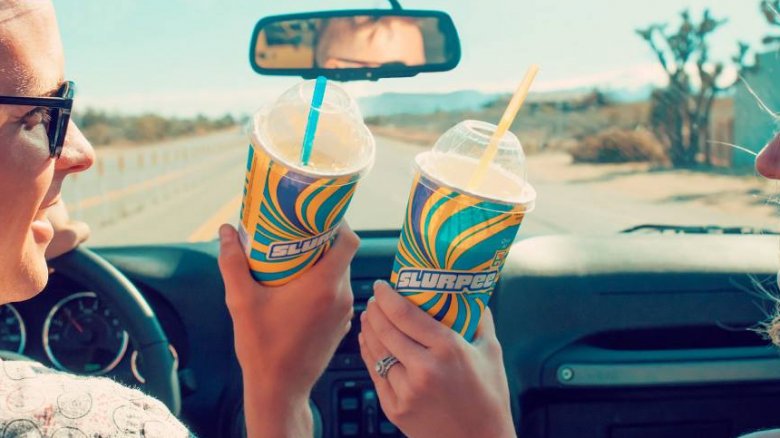The Untold Truth Of 7-Eleven's Famous Slurpee
If you live in America (or even if you don't), you've probably heard of the iconic Slurpee, a time-honored beverage beloved by millions. The Slurpee is carbonated slush drink sold self-serve style, at 7-Elevens around the world. Every year, the Japanese-owned American chain churns out enough cup-fulls of Slurpee to fill 12 Olympic-sized swimming pools.
If you live in the U.S., Japan, Canada, or any of the other countries where fine 7-Elevens are ubiquitous, you've likely slurped a Slurpee or 307 in your lifetime. You may have tugged that self-serve lever and filled your colorful wax paper cup with every flavor imaginable, from the tangy Mandarin Jarrito to the bold Cap'n Crunch Crunch Berries. But whether you're a seasoned Slurpee snob or Slurpee virgin, we're willing to bet there are a few secrets about this legendary drink you never knew.
Ready to have your brain frozen, then blown? Read on to learn the untold truth of 7-Eleven's famous Slurpee.
The Slurpee was discovered by accident ... at a Dairy Queen
The Slurpee's story begins in an unlikely place: not a 7-Eleven, but a Kansas Dairy Queen with a finicky soda fountain. It was the late 1950s, and the Dairy Queen's owner, Omar Knedlik, took to storing bottles of soda in the freezer when his soda fountain malfunctioned. Whenever he accidentally left the bottles in the freezer a bit to long, sodas would emerge from the freezer partially frozen. To Knedlik's surprise, customers were wild about the slushy soda pops and began requesting them specially.
Inspired, Knedlik cobbled together a machine from a car A/C unit that would churn out semi-frozen, carbonated beverages. The machine infused carbon dioxide into a frozen concoction of flavor and water to create the fizzy drink. Knedlik partnered with an engineering firm in Dallas to perfect the design, and began selling the newly christened ICEE machine to diners, restaurants, gas stations, and convenience stores.
In 1965, 7-Eleven licensed the ICEE machine from Knedlik and rebranded the drink as the "Slurpee". 7-Eleven ad agency director Bob Stanford was credited with coming up with the name "Slurpee" based on the noise the drink makes as it is sucked through a straw. By the time the 1970s rolled around, there would be a Slurpee machine in every 7-Eleven across the country.
Some of the early Slurpee flavors were a little unusual
When the Slurpee first hit 7-Eleven stores, it was available in two flavors: Coca-Cola and cherry. By the time the 1970s rolled around, the Slurpee had expanded to 27 different flavors, some with unorthodox, slightly edgy-sounding names. Some of the more popular flavors actually sounded like strains of weed rather than kid-friendly fountain drinks. To name a few: For Adults Only, Fulla-Bulla, Red Eye, Scooby Doo, Green & Wet, and Bull Corn.
Since the Slurpee's inception, 7-Eleven has ditched some of its more adult-sounding names, but introduced hundreds of flavors. Slurpee scientists are constantly tweaking recipes and dreaming new ones. In the U.S., some of the most popular flavors are Fanta Wild Cherry, Coca-Cola Classic, Fanta Banana, Barq's Root Beer, Fanta Pina Colada, and Mountain Dew. For the truly intrepid, there's the notorious Suicide Slurpee: an unofficial flavor that involves dispensing mix from every single machine into one cup.
The Slurpee machine hasn't changed much in the last 50 years
Although flavors have come and gone, the design of the Slurpee machine has remained much the same over the last half century. The intention is that whether you drink a Slurpee in Idaho or Tokyo, you'll still be getting basically the same frosty refreshment.
While 7-Eleven keeps the exact blueprint of its Slurpee machine confidential, the Smithsonian Magazine does a good job of breaking down it's basic mechanics. The Slurpee machine features a refrigerated barrel, which both cools and churns the mixture to break up the ice chunks and retain the slushy texture. The drink is kept from freezing completely in part because of the sugar content, which lowers the freezing point of water. At the same time, the Slurpee machine pumps the beverage with carbon dioxide to give the Slurpee its signature light and fizzy texture.
As one former 7-Eleven staff member explained, the employees' primary contribution to this process is to hook up a bag-in-a-box of drink syrup to the machine in the backroom (which is also hooked up to carbon dioxide and water). You, the customer, take it from there.
An early Slurpee jingle has become a cult classic
Slurpees are, and always were, a cool kids drink. From the beginning, Slurpee marketers targeted kids, teens, and young adults with psychedelic cup designs and groovy jingles. So groovy were these jingles, in fact, listeners would actually call into radio stations to request them, recalls Priceonomics.
The grooviest of all these melodies was arguably "Dance the Slurp," a full-length jingle written by Tom Merriman, one of America's most influential jingle composers. It's a lively, two-minute tune that consists of funky brass music and slurping sounds, punctuated with people occasionally exclaiming, "slurp, slurp!" The song was released on vinyl 45 in the 1960s and handed out for free at 7-Eleven stores.
Years later, "Dance the Slurp" was remixed by Cut Chemist and DJ Shadow in their 1999 album Brainfreeze. Today, copies of the original "Dance the Slurp" 45s are considered super rare, and the once-free records sell on eBay for as much as $50.
The Slurpee revolutionized the straw
Remember that dark time in human history when you had spoons and you had straws, but nothing in between? So if you wanted to, say, drink a milkshake, you had two choices. Either struggle to sip the high-viscosity liquid through a straw like a chump, or resort to scooping it straight into your mouth with a spoon like a savage. When it came to impressing on first dates, neither tactic was ideal.
The Slurpee changed all this with the introduction of its signature spoon straw. The pioneering utensil was developed by Arthur A. Aykanian, an industrial designer who trained as a mechanical engineer at MIT.
The spoon straw is beautiful in its simplicity. At first glance, it looks like your average straw. But upon closer examination, you'll notice the bottom features a tiny scoop. With the spoon straw, you can alternate between digging into the icy layer that sits atop your Slurpee and sipping the melted liquid at the bottom like a traditional straw.
Since the release of the spoon straw, 7-Eleven has introduced additional, limited edition Slurpee straws, including edible candy straws and collectible tongue straws.
7-Eleven trademarked the term BrainFreeze
The sudden headache that may occur when you eat or drink something cold very fast has a scientific name, and it's very tough to pronounce. Sphenopalatine ganglioneuralgia, also called a cold-stimulus headache, is a biological mechanism that is triggered when you suddenly change the temperature in the back of your throat. This area is the intersection of the internal carotoid artery, which delivers blood to the brain, and the anterior cerebral artery, where the brain tissue begins. An overly cold substance will cause these two arteries to dilate and contract, sending a signal that the brain reads as pain.
You probably know the whole process of sphenopalatine ganglioneuralgia by another name: a brain freeze. The term was actually coined (they claim) and trademarked (spelled "BrainFreeze") by 7-Eleven. Anyone who has anyone who has ever chugged a Slurpee a little too eagerly understands why.
The next time the dreaded brain freeze hits when you're guzzling a Wild Cherry or pina colada Slurpee, there are a few tricks you can try for a speedy recovery. First, stop drinking your Slurpee ASAP (just for a second, don't worry). Next, hold your tongue against the roof of your mouth. If that doesn't work, trying covering your mouth and nose and breathing to warm the air.
You'll never guess which country drinks the most Slurpees
With their long, hard winters, Canadians seem like unlikely candidates for the world's biggest Slurpee fans. But of the more than dozen countries where Slurpees are sold, Canada consumes more of these flavored frozen drinks than any other. Manitoba, one of the coldest provinces in the Northern Hemisphere, has been named Slurpee Capital of the World 19 years in a row for having the highest annual average number of Slurpees sold per store in one region. After hitting the 19th-year landmark, Winnipeg, the capital city of Manitoba, renamed a street "Slurpee Way" in honor of the drink.
According to Access Winnipeg, the Slurpee is a popular breakfast beverage year-round, and a common fixture at everything from summer weddings to winter football games in Manitoba. Locals bring Slurpees to friends and family staying in maternity wards during the summer, and greet visitors at the airport with cups of Slurpees rather than flowers.
A ton of Slurpee flavors are certified kosher
From the Hebrew word kashrus or "pure," kosher is a certain type of food preparation that complies to Jewish law. Kosher rules can be quite comprehensive and complex, restricting the way certain foods can be harvested, processed, and prepared, and forbidding certain products and ingredients.
Considering the intricacy of kosher law, you might not have imagined that many Slurpee flavors would meet the strict Kosher Certification guidelines., but they do—particularly, Slurpees from kosher-certified brands like Canada Dry, Dr. Pepper, Hawaiian Punch, Squirt, and Sunkist.
The OU Kosher Certification Agency has released and updates a complete list of certified Kosher Slurpees. Popular choices like Coca-Cola Classic and watermelon Sour Patch are kosher, but so are plenty of funkier picks like sugar-free lite pineapple coconut, lime, Eureka! California, and Sprite 6 by LeBron James.
According to OK Kosher Certification, select dairy Slurpees and other flavors don't meet the Kosher certification cut. Similarly, the association warns that many off-brand slush products from competitor convenience stores and gas station may not use Kosher certified mixes.
You may want to steer clear of Slurpee Lites
Way back in 2012, 7-Eleven launched a low-calorie line of sugar-free Slurpees dubbed the Slurpee Lite. These "diet-friendly" Slurpees are made from artificial sweetener, sucralose (aka Splenda), and include only 20 calories per 8 fluid-ounce or one-cup serving. By comparison, your standard, sugar-full Slurpee includes 65 calories per 8-ounce serving and around 18 grams of sugar.
The very first Slurpee Lite to hit the stores was the Fanta Sugar-Free Mango, followed by Fanta Watermelon Lime and Fanta Sugar-Free Strawberry Banana. Today, you can find these and a number of other Fanta-engineered sugar-free Slurpee flavors.
But while an absence of sugar and lack of calories may be attractive to some dieters, some nutritionists warn you should approach the sugar-less edition with caution. Your average sugar-free Slurpee comes with packed with scary preservatives like erythritol, a sugar alcohol that causes gastrointestinal problems for many drinkers, and yellow 8, a food coloring that has been linked to increased risk of cancer. And Splenda, the drink's primary replacement for sugar, has been shown to cause diarrhea in rats.
The Slurpee has multiple national holidays
You may be familiar with 7-Eleven Day (unofficially referred to as "National Slurpee Day") which predictably falls on July 11. On this magical holiday, 7-Elevens across the U.S. hand out free small Slurpees from 11 a.m. to 7 p.m. But the fun doesn't stop on July 11: the chain celebrates the entire week of 7-Eleven Day with promos on drinks, candy, and treats.
A lesser known, equally awesome Slurpee holiday is Bring Your Own Cup Day, which typically falls during the spring and summer months. In honor of the holiday, customers can fill up their own, any-size cup with Slurpee nectar for $1.50. In the past, people have gone a little wild on BYO Cup day, emerging from 7-Elevens lugging everything from water jugs to kiddie pools filled with Slurpees.
Since then, 7-Eleven has introduced some restrictions: vessels must fit upright through a 10-inch cutout, they must be food-safe and watertight, and customers are limited to one cup each. The rules haven't stopped Slurpee fans from getting creative though. On BYO Cup Day, you'll see Slurpee fans loading up with everything from hollowed-out pineapples to Halloween pails.
You can go on a cross-country Slurpee road trip
Need an excuse to take trans-America a road trip? Why not make it Slurpee themed? There are a number of Slurpees you can only order in certain regions, paving the way for a fun, brain freeze-fraught adventure through the 7-Eleven's of America. Here's an itinerary:
Start in California, scouring 7-Elevens to hunt down the illusive California Blackberry Lime. This Golden state-exclusive Slurpee is blended with blackberries, lime, and real fruit juice.
Then, head south to Nevada or Arizona to locate the Cactus Cooler. This somewhat deceptively named Southwest Slurpee blends orange and pineapple flavors (but no cactus).
Texas is next. In major cities, you can discover the frosty Manzanita Sol. These Lone Star Slurpees are based on the crisp, tart apple Mexican soda of the same name.
Head towards Detroit, where 7-Elevens are serving up the Vernors Boston Cooler. This Slurpee was inspired by Vernors Ginger Ale, a Detroit original.
Pop by New York City, where you can pour yourself a giant cup of Dr. Brown's black cherry soda Slurpee at many 7-Elevens. Dr. Brown's sodas are beloved in the Big Apple.
Head down the East Coast to locate Canada Dry Cranberry Ginger Ale, served at 7-Elevens in Baltimore and Philadelphia. This seasonal flavor is made with cranberry flavor and real ginger.
End your icy, epic journey in Virginia, where you can pick up a Slurpee is for Lovers Sour Lime. As its name suggest, this one contains a tangy, sweet blend of lemon and lime.
